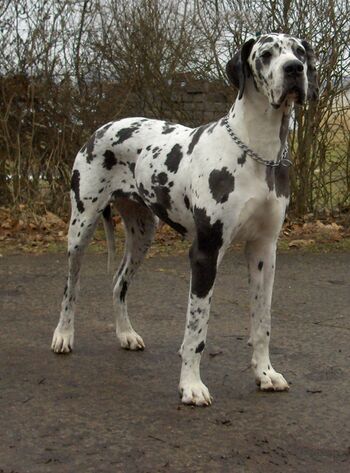Great Dane: Difference between revisions
imported>Nancy Sculerati MD No edit summary |
imported>Nancy Sculerati MD |
||
| Line 13: | Line 13: | ||
=Health concerns= | =Health concerns= | ||
Each purebred dog has some particular health problems that are more common in its breed than in other breeds Some of these concerns are due to [[recessive genes]] that are more likely to "show" in animals that come from related ancestors. Other problems have to do with the "downside" of the typical physical features characteristic of a breed. Great Danes are more likely to suffer difficulties associated with being very large. | Each purebred dog has some particular health problems that are more common in its breed than in other breeds Some of these concerns are due to [[recessive genes]] that are more likely to "show" in animals that come from related ancestors. Other problems have to do with the "downside" of the typical physical features characteristic of a breed. Great Danes are more likely to suffer difficulties, such as "bloat" that are associated with being very large. | ||
=External links= | =External links= | ||
The American Kennel Club's website: Great Dane breed standard [http://www.akc.org/breeds/great_dane/index.cfm] | The American Kennel Club's website: Great Dane breed standard [http://www.akc.org/breeds/great_dane/index.cfm] | ||
Revision as of 23:53, 4 February 2007
The Great Dane is the largest of all the breeds of dog. The tallest of the working breeds, with males standing no less than 30 inches (76 cm) at the top of the shoulders and females at least 28 inches (71 cm); it weighs 120 to 150 pounds (54 to 68 kg).
Classed as a member of the 'working group 'by the Kennel Club (Great Britain) and as a 'working dog' by the American Kennel Club, its name is derived from "the old Fench designation, grand Danois, meaning Big Danish".(ref Great Dane in The Complete Dog Book page 271). George Buffon, an eighteenth century French naturalist, used this name in describing the breed, and the English speaking world has since used its translation. "The German, however, use the name Deutsche Dogge (German Mastiff), which is closer to the truth, because the present day dog was developed by German breeders during the nineteenth century. The Great Dane was first displayed at a Hamburg dog show in 1862."( Great Dane in Book of Dogs page 162
Great Danes are recognized in many colors. Brindle Fawn Blue Black Harlequin Mantle
Health concerns
Each purebred dog has some particular health problems that are more common in its breed than in other breeds Some of these concerns are due to recessive genes that are more likely to "show" in animals that come from related ancestors. Other problems have to do with the "downside" of the typical physical features characteristic of a breed. Great Danes are more likely to suffer difficulties, such as "bloat" that are associated with being very large.
External links
The American Kennel Club's website: Great Dane breed standard [1]
